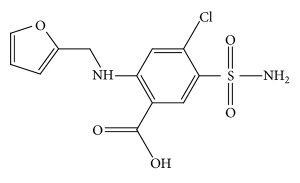Loop diuretics
From WikiLectures
Loop diuretics act by blocking Na + transport in the ascending part of Henle's loop. This disrupts the osmotic stratification of the kidney and significantly increases diuresis. Compensatory mechanisms in the distal tubule and collecting duct lead to the exchange of Na + for K + , which can lead to severe hypokalemia. Therefore it is necessary to monitor potassium levels, or increase its intake by KCl infusion, or to combine loop diuretics with Potassium-sparing diuretics. With K ions + , Cl ions - are also lost, which can cause hypokalemic, hypochloremic metabolic alkalosis. At the same time, the tubular resorption of Ca 2+ and Mg 2+ also decreases.
Representatives[edit | edit source]
The most commonly used one is furosemide.
Effects and uses
- It reduces preload by vasodilation.
- When administered intravenously, the onset of action is rapid (within 10 minutes) and lasts for 2-3 hours.
- Used in acute conditions: hypertensive crisis, pulmonary edema, congestive heart failure, hypercalcemia.
Side effects
- Disorders of water and ion balance,
- hypovolemia, hemoconcentration to dehydration and hypotension,
- hyperuricemia, GIT disorders, rash, hematopoietic disorders,
- increases toxicity of cardiac glycosides.
Links[edit | edit source]
Source[edit | edit source]
- MARTÍNKOVÁ, Jiřina – MIČUDA, Stanislav – CERMANOVÁ, Jolana. Selected chapters from clinical pharmacology for bachelor study : Cardiovascular system [online]. [cit. 2000]. <https://www.lfhk.cuni.cz/farmakol/predn/bak/kapitoly/prednasky/kardio-bak.ppt/>.
- ŠTĚRBA, Martin. Selected chapters from pharmacology - lectures / seminars : Diuretics [online]. [cit. 2008]. <https://www.lfhk.cuni.cz/farmakol/predn/cz/2008/2008-diuretika_web.ppt/>.
- LINCOVÁ, Dagmar – FARGHALI, Hassan. Basic and applied pharmacology. 2. edition. Galén, 2007. 0 pp. ISBN 978-80-7262-373-0.


